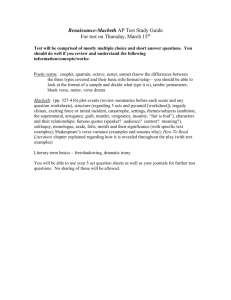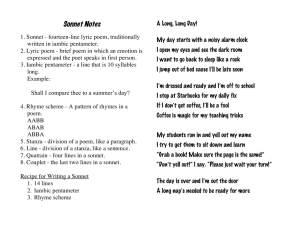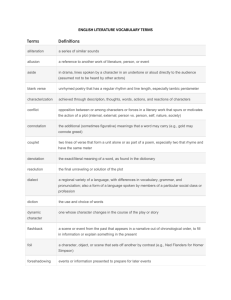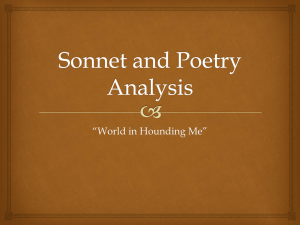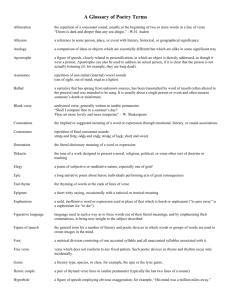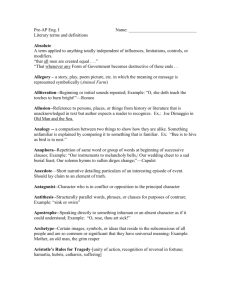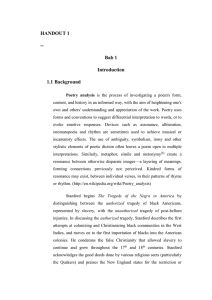A.P. Lit terms
advertisement
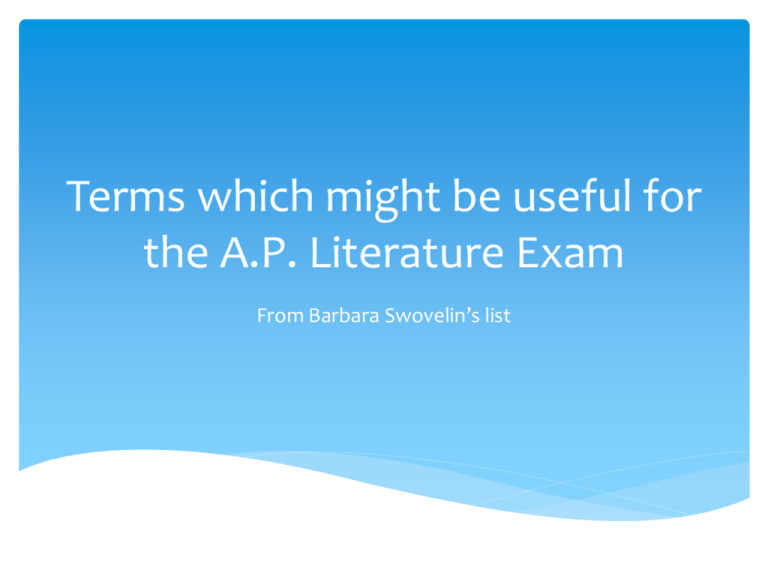
Terms which might be useful for the A.P. Literature Exam From Barbara Swovelin’s list Ad hominem argument From the Latin meaning “to or against the man,” this is an argument that appeals to emotion rather than reason, to feeling rather than intellect. alliteration close repetition of consonant sounds at beginning of words allusion brief reference to familiar person/thing/incident (often Biblical, historical, mythological or literary) apostrophe directly addressing an absent or imaginary person assonance repetition of vowel sounds ballad narrative poem, originally sung (ballade: a French verse form) bathos excessive pathos caesura pause in line, dictated by rhythm (“A little learning…..is a dangerous thing) consonance close repetition of identical consonant sounds around different vowels (flip-flop, or at the ends of words (hid-bed) couplet two lines of verse, usually rhymed and of same meter denoument events following the climax and falling action (resolution) Deus ex machina “god from machine” (saves the day) diction the choice of words and their placement in sentences dissonance juxtaposition of jarring sounds doggrel rough, crudely written verse, usually comic elegy dignified poem mourning death end-stopped line end of phrase or sentence coincides with end of line (poetry) epic extended narrative poem, exalted in style and heroic in theme Epic (Homeric) simile extended simile epigram short, witty statement, graceful and ingenious epilogue final section of speech or written work (peroration) epiphany “showing forth” (Greek), an insight epitaph death inscription (“On the whole, I’d rather be in Philadelphia” W.C. Fields) epithet term used to characterize a person (Jack the Ripper) fable truth narrative illustrating a moral Figurative language makes use of figures of speech (techniques comparing dissimilar objects); specific figures of speech are listed separately foot group of syllables forming metrical unit: iamb trochee anapest dactyl form fixed metrical arrangement Free verse lacks regular meter and line length (relies on natural rhythm; most modern poetry) gallows humor black humor (like dead baby jokes) Genre literary type or class, specific or general (carpe diem poetry, tragedy, novels, etc.) Heroic couplet pair of rhymed iambic pentameter lines hyperbole deliberate exaggeration imagery language which evokes sensory experiences; engaging sight, smell, taste, etc. irony writer expresses a meaning contradictory to stated or ostensible one: Verbal irony: attitude opposite to what is literally stated. Dramatic irony: situation understood in double sense by audience (and not by characters on stage). Situational irony: circumstances turn out to be reverse of those anticipated litotes or meiosis; understatement (in Hamlet, “a play of some interest”) lyric originally (Greek) sung to lyre; lyric poetry expresses feelings of speaker in words which have musical qualities metaphor two unlike objects compared (“Life is but a walking shadow”) metonymy figure of speech, name of object substituted for another (“my light [vision] is spent”) meter pattern of stressed and unstressed syllables; see foot, a foot being the metrical unit; the following terms refer to number of feet per line: monometer, dimeter, trimeter, tetrameter, pentameter, hexameter, heptameter, octometer. Iambic pentameter refers to a line of five feet of iambs motif recurring image, character, verbal pattern, etc. Narrative verse tells a story (as does anything narrative) ode lyric poem of some length, serious in subject and dignified in style onomatopoeia words whose sounds express or reinforce their meanings Ottava rima eight lines, iambic pentameter (abababcc) oxymoron two apparently contradictory terms (cold fires; conspicuous by his absence) Pathetic fallacy human characteristics given to inanimate objects pathos quality which evokes feelings of pity, sympathy, tenderness, etc persona a “mask” which the author assumes to speak to the audience personification inanimate objects endowed with human qualities Petrarchan sonnet 14 lines divided into two parts, an octave (abbaabba) and sestet (cdecde) quatrain stanza of four lines repetition duplication of an element of language, such as a word, phrase, clause, etc Rhyme royal 7-line stanza in iambic pentameter (ababbcc) Shakespearean sonnet 14 lines, iambic pentameter (abab cdcd efef gg or abba cddc effe gg) simile comparison using “like” or “as.” Spenserian sonnet same with rhyme of abab bcbc cdcd ee stanza group of lines that form division of a poem style the qualities that make up a literary personality or way of writing syllogism a deductive, logical argument, formulated around one major premise, one minor premise, and a conclusion (e.g. All men are mortal; Socrates is a man; therefore, Socrates is mortal.) symbol something that stands for something else, but also exists as an entity itself (a hammer and sickle for the USSR) synecdoche part represents the whole (all hands on deck) syntax the choice of words and their placement in sentences tercet a group of three lines rhyming together or connected by rhyme with the adjacent group or groups of three lines Terza rima aba bcb cdc etc tone author’s attitude toward (can also be towards audience or both) villanelle a French fixed form (5 tercets and a quatrain, all with two rhymes) Those are your terms, learn them and use them when appropriate.

